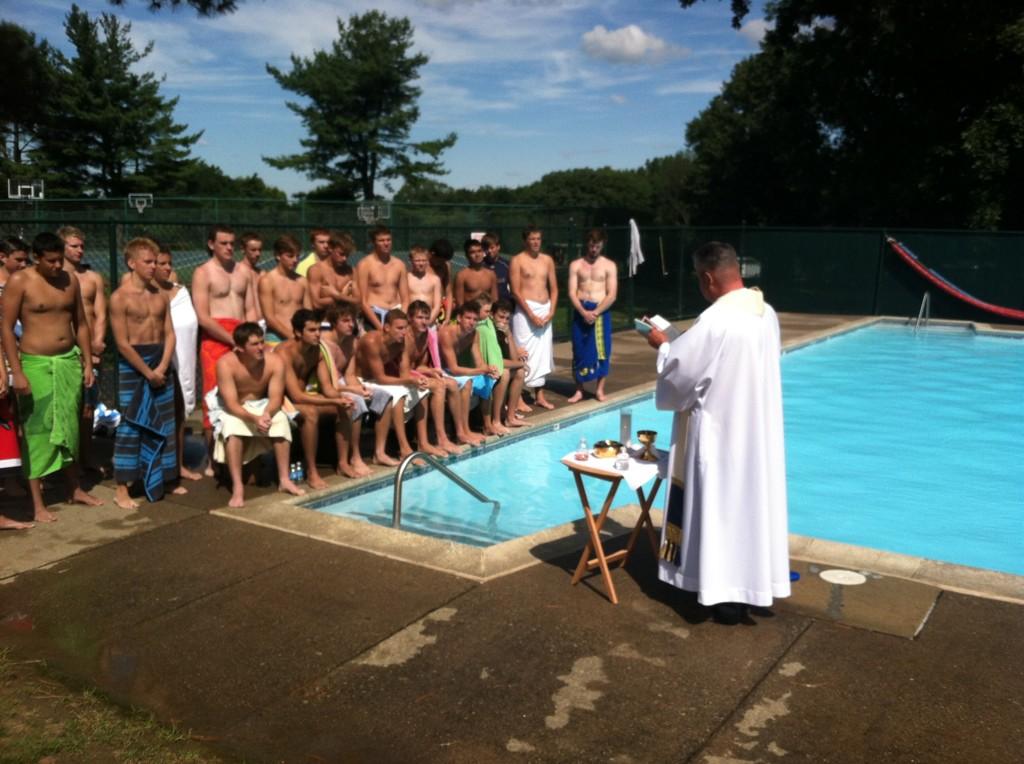NOVUS ORDO: Surfing, Bikini Mass!
WARNING: IMMODESTY
YIKES! PICTURES WITHIN...
[Beyond the pool-side Mass!]

[Beyond the beach-front Mass!]
[Beyond the in-the-pool Mass!]
Text: Giuseppe Nardi – Post and trans: Tancred – 6/27/18
Edit: did Brian Wilson compose the Credo?
(Rome)
Since the liturgical reform there have been two forms of Communion
reception: the orderly form of the kneeling Communion on the tongue and
the exception of the standing hand communion. It is well-known that the
exception has long since been promoted by the majority of bishops and
the clergy, at least in the German-speaking world, almost the sole form.
But that does not exhaust the repertoire. Lately, there is also the
floating bikini communion.

Mass at the quay with miniature altar
Last Sunday, the Feast of St. John the Baptist, a Holy Mass was
celebrated on the beach in Portonovo in the Marche. Portonovo is a
district of Ancona and officially has only one inhabitant, but several
hotels and holiday homes. On the beautiful Adriatic beaches at the foot
of Monte Cornero, hundreds of holidaymakers arrive in summer.
Obviously, in order to reach them, a priest celebrated Mass on the
wharf beside the main beach. A small table served as an improvised altar
from the guest garden of the adjoining bar. Some of the bathers
attended the Mass in the water or on surfboards. Communion was also
given by the priest to those in the water. Of course he had to squat
down on the edge of the quay. Comfort must be – for the faithful.
Just one kilometer from the quay stands on a small hill directly
above the beach, the church of Santa Maria di Portonovo, a jewel of
church architecture. It is considered a masterpiece of Romanesque
architecture in Italy and is even mentioned by Dante in Cantus XXI of
his Divine Comedy.

Santa Maria di Pontenovo on Monte Cornero
A thousand years ago Benedictines, probably of Norman origin,
settled in this once isolated place. They built the church, first
mentioned in 1034, and a monastery.
In the monastery, St. Gaudentius (1018-1042), Bishop of Osor on the
Croatian island of Cres, found refuge, who had to flee from local
potentates for his defense of the marriage Sacrament. Osor, today a
small village with only 73 inhabitants, was an important city in the
Middle Ages before malaria forced its decline. The former diocese is now
part of the diocese of Krk. Gaudentius was received into the
Benedictine Order by the great Doctor of the Church, Peter Damiani and
entered the monastery on Monte Cornero.
After an earthquake and the risk of falling rocks, the Benedictines
gave up the monastery in 1320, which was subsequently inhabited by
hermits. A bloody raid by Muslim pirates in 1518 gave this place of
religious life the coup de grace.

Santa Maria di Portonovo seen from the mountain
The remains of the ruined monastery buildings were used by the
French in 1811 as building material for the construction of a coastal
fort against the Royal Navy.
In 1837, the monk and later founder of the Benedictine Congregation
of Subiaco, Pietro Francesco Casaretto, took over the still existing
church. He retired for some time as a hermit to Santa Maria di
Pontenovo. He had renovations carried out, which ensured the existence
of the church. At the same time the tomb of St. Gaudentius was found.
Is it too much to ask that the faithful to come to Church for three
quarters of an hour, or is the beach more important to them on Sunday?

New form of communion reception: swimming bikini communion.

Masterpiece of Romanesque church architecture
Inside of Santa Maria di Pontenovo
